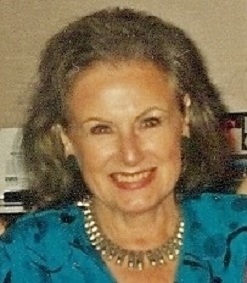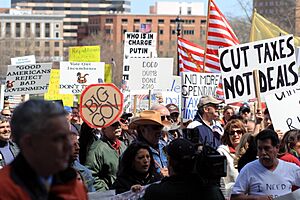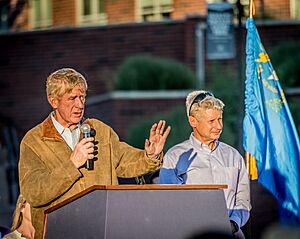History of the Libertarian Party (United States) facts for kids
The Libertarian Party is a political group in the United States. It was started in Colorado Springs, Colorado, on December 11, 1971. A group of people led by David Nolan formed the party. They felt the government was getting too involved in the economy, like when President Richard Nixon put limits on prices and changed how money worked.
The Libertarian Party believed that the main political parties (Republicans and Democrats) had moved away from the ideas of freedom and limited government that America's Founding Fathers believed in. Key people who helped start the party included John Hospers, Edward Crane, and Theodora (Tonie) Nathan.
Contents
Starting the Party

The new party held a press conference on January 31, 1972, to announce its creation. Their first big meeting, called a national convention, happened in June 1972 in Denver, Colorado. It brought together 89 people from 23 states.
Early on, some Libertarians were elected to local offices. For example, Miguel Gilson-De Lemos was elected to a local board in New York. This gave the party hope for the future. Over the years, the number of Libertarians holding office slowly grew.
In 1972, the party chose John Hospers as their candidate for president. Tonie Nathan was chosen as his running mate for vice president. By the 1972 election, the party had over 80 members. They were able to get their candidates listed on the ballot in two states.
Hospers and Nathan received between 3,000 and 4,000 votes. However, they made history by getting one vote in the Electoral College. This vote came from Roger MacBride of Virginia, who was supposed to vote for Richard Nixon. This was also the first time a woman received an Electoral College vote. MacBride later became the party's presidential candidate in 1976.
In 1978, Dick Randolph became the first Libertarian to win a state-level office. He was elected to the Alaska House of Representatives.
Growing the Party
In the 1980 presidential election, the Libertarian Party made a big step. Their candidates, Ed Clark and David H. Koch, were listed on the ballot in all 50 states, plus Washington, D.C., and Guam. This was the first time a "third party" (not Republican or Democrat) had done this since 1916. Clark and Koch spent a lot of money on their campaign and received almost one million votes. This was more than one percent of all votes cast.
The party also ran more candidates for the United States House of Representatives than any other smaller party since 1980. In 1981, Richard P. Siano became the first Libertarian to win a local election in the main part of the United States. He was elected to the Kingwood Township Committee in New Jersey.
In 1987, Doug Anderson became the first Libertarian elected to office in a major city. He was elected to the Denver Election Commission.
In 1988, former Republican Congressman Ron Paul became the Libertarian candidate for president. He was on the ballot in 46 states. Paul later returned to the Republican Party and served in the U.S. House of Representatives again. His running mate was Andre Marrou, who had served in the Alaska legislature.
From the 1990s to Early 2000s
In 1992, Andre Marrou ran for president with Nancy Lord as his running mate. Their ticket was on the ballot in all 50 states, D.C., and Guam. This was the first time since 1980 that the Libertarian presidential ticket achieved this.
Investment adviser Harry Browne was the party's presidential candidate in both 1996 and 2000. In 1996, his running mate was Jo Jorgensen. In 2000, it was Art Olivier. The party's presidential candidates were on the ballot in all 50 states in 1996. In 2000, they were on the ballot in 49 states.
In 2000, the Arizona Libertarian Party, which was separate from the national party at the time, chose different candidates. They nominated science fiction writer L. Neil Smith and newspaperman Vin Suprynowicz for president and vice president in Arizona.
2004 to 2007 Elections
The 2004 presidential nomination race for the Libertarian Party was very close. Three candidates were in the running: Michael Badnarik, Gary Nolan, and Aaron Russo. Badnarik was chosen as the party's presidential candidate. Many people were surprised because he wasn't a top choice at first. His strong performance in a debate helped him win.
The Badnarik campaign got on the ballot in 48 states (plus D.C. and Guam). They received 397,265 votes. His running mate was Richard Campagna.
In the 2006 elections, Libertarian candidates received over 13.4 million votes. In 2007, Libertarian Party candidates won 14 elected offices, including the mayor of Avis, Pennsylvania.
2008 Bob Barr Campaign
Several people wanted to be the party's presidential candidate in 2008. Ron Paul, who had been the party's 1988 candidate, was considered, but he decided not to run as a Libertarian. On March 25, 2008, Mike Gravel switched from the Democratic Party to the Libertarian Party.
Ten days before the 2008 Libertarian National Convention, Bob Barr, a former Republican U.S. Congressman, announced he would seek the nomination. On May 25, after six rounds of voting, the Libertarian Party chose Barr as their official candidate for president. Wayne Allyn Root was chosen as his running mate.
2009–2012: Tea Party Protests and Growth

Protests happened because of economic problems and a new healthcare law. These protests, called the Tea Party movement, helped both the Libertarian and Republican parties. Protesters wanted the government to follow the United States Constitution more closely. They also wanted less government spending and lower taxes. These ideas are supported by the Libertarian Party.
2012 Gary Johnson Campaign

After trying for the Republican nomination, former Governor of New Mexico Gary Johnson decided to seek the Libertarian nomination. Johnson was known for wanting to reduce U.S. involvement in wars and for being careful with government money. As governor, he cut taxes many times.
Johnson won the nomination. He came in third place in the general election, receiving 1,275,821 votes. This was the most votes any Libertarian Party presidential candidate had received at that time.
2016 Gary Johnson Campaign

At the Libertarian Party National Convention in Orlando, Florida, in May 2016, Gary Johnson again became the Libertarian Party candidate for president. His running mate was former Governor of Massachusetts Bill Weld. They were on the ballot in all 50 states and D.C.
Johnson became the most popular Libertarian presidential candidate ever, getting 4,489,233 votes. This was 3.3% of the national vote. Many of Johnson's supporters were young people.
However, Johnson's campaign is often remembered for a mistake he made. On a TV show, he was asked about "Aleppo" (a city in Syria that was in a war). Johnson asked, "And what is Aleppo?" This mistake made some people doubt his knowledge of world events. His support in polls dropped after this.
2020 Jo Jorgensen Campaign
At the Libertarian Party National Convention held online in May 2020 (due to the COVID-19 pandemic), Jo Jorgensen became the Libertarian Party candidate for President. She was the first woman to be the party's presidential candidate. Jorgensen won after several rounds of voting. Activist and podcaster Spike Cohen became her vice-presidential running mate.
Jorgensen and Cohen were on the ballot in all 50 states and D.C. They received 1,865,535 votes, which was 1.2% of the national vote. They came in third place nationally. This was the second-highest number of votes for a Libertarian presidential candidate.
Presidential Tickets
|
1972: John Hospers and Tonie Nathan – 3,674 popular votes (nil%); 1 electoral vote |


